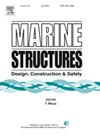Theoretical and data-driven methods to predict the mechanical response of flexible pipe carcass under radial compression
IF 5.1
2区 工程技术
Q1 ENGINEERING, CIVIL
引用次数: 0
Abstract
The carcass layer is the innermost structure of flexible pipes and is primarily designed to resist radial loads. Flexible pipes are subjected to compression by tensioners during installation, and excessive radial loads can lead to plastic deformation and premature material yielding, consequently diminishing the structural load-bearing capacity. Despite the critical role of the carcass layer, limited research has been performed on the plastic analysis of its complex cross-section under symmetric radial compression. This study applied the plastic-hinge theory to a planar circular ring, considering factors such as ellipticity and material hardening, and introduced the concept of equivalent radial stiffness for the carcass layer to predict the load-displacement curve during the plastic phase of the carcass layer under radial compression. Simultaneously, owing to the challenge of uneven stress distribution caused by a complex cross-section, this study adopts a combined approach of the attention mechanism and Long Short-Term Memory (LSTM) neural network. By inputting the structural ellipticity, inner diameter, and load–displacement response, the method aims to accurately predict the stress in the carcass layer. This conclusion indicates that the theoretical model exhibits a higher prediction accuracy when material hardening is considered. Errors arise when material hardening is ignored, as the theoretical model fails to account for the deformation of nonuniform cross-sections. By contrast, the data-driven models demonstrated high precision in predicting both radial and circumferential stresses in the carcass layer under radial compression.
径向压缩下柔性管体力学响应预测的理论与数据驱动方法
胎体层是柔性管道的最内层结构,主要用于抵抗径向载荷。柔性管在安装过程中受到张紧器的压缩,过大的径向载荷会导致塑性变形和材料过早屈服,从而降低结构的承载能力。尽管屠体层具有至关重要的作用,但对其复杂截面在对称径向压缩下的塑性分析研究有限。将塑性铰理论应用于平面圆环,考虑椭圆性和材料硬化等因素,引入等效径向刚度概念,预测径向压缩下胴体层塑性阶段的载荷-位移曲线。同时,由于复杂截面造成应力分布不均匀的挑战,本研究采用了注意机制与长短期记忆(LSTM)神经网络相结合的方法。该方法通过输入结构椭圆度、内径和荷载-位移响应,准确预测胴体层内的应力。这一结论表明,考虑材料硬化的理论模型具有较高的预测精度。当忽略材料硬化时,由于理论模型不能考虑非均匀截面的变形,会产生误差。相比之下,数据驱动模型在预测径向压缩下胴体层的径向和周向应力方面显示出较高的精度。
本文章由计算机程序翻译,如有差异,请以英文原文为准。
求助全文
约1分钟内获得全文
求助全文
来源期刊

Marine Structures
工程技术-工程:海洋
CiteScore
8.70
自引率
7.70%
发文量
157
审稿时长
6.4 months
期刊介绍:
This journal aims to provide a medium for presentation and discussion of the latest developments in research, design, fabrication and in-service experience relating to marine structures, i.e., all structures of steel, concrete, light alloy or composite construction having an interface with the sea, including ships, fixed and mobile offshore platforms, submarine and submersibles, pipelines, subsea systems for shallow and deep ocean operations and coastal structures such as piers.
 求助内容:
求助内容: 应助结果提醒方式:
应助结果提醒方式:


